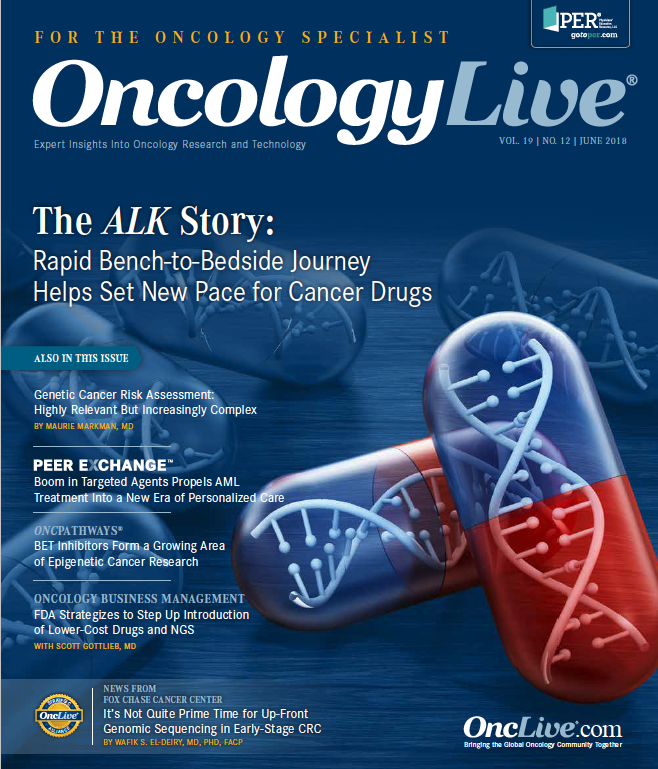Publication
Article
Oncology Live®
Novel Cancer Vaccine May Improve Survival in Synovial Sarcoma
Author(s):
Investigators are hopeful that CMB305, a vaccine that boosts the immune response to tumor cells expressing the antigen NY-ESO-1, can improve survival outcomes for patients with synovial sarcoma.
William D. Tap, MD
Investigators are hopeful that CMB305, a vaccine that boosts the immune response to tumor cells expressing the antigen NY-ESO-1, can improve survival outcomes for patients with synovial sarcoma, a rare subtype of soft tissue sarcoma that primarily develops in the arms and legs and affects about 800 individuals in the United States each year. Patients with advanced disease have poor odds for survival, and even good responses to standard chemotherapy can often last just a few months.
“We know [that] patients with synovial sarcoma, especially when they present with locally advanced or metastatic disease, are often not curable,” said William D. Tap, MD, chief of the Sarcoma Medical Oncology Service at Memorial Sloan Kettering Cancer Center in New York, New York. He said that after patients stop chemotherapy treatment, their disease often progresses. Clinicians can often re-treat with chemotherapy, but due to the toxicities, this is not always an option, and there are limited agents available for subsequent lines of therapy.
Figure. CMB305 in Synovial Sarcoma
In the phase III Synovate Study, CMB305 will be tested as maintenance monotherapy in patients with locally advanced, unresectable, or metastatic synovial sarcoma after initial treatment with chemotherapy (NCT03520959). Investigators seek to enroll approximately 248 patients who have achieved at least stable disease (Figure).1 Eligible participants must have expression of the NY-ESO-1 surface protein, which is commonly found in synovial sarcoma tumors and is shown by immunohistochemical testing. CMB305 combines 2 mechanisms of action in 1 vaccine targeting the antigen NY-ESO-1. The prime component is an engineered lentiviral vector that binds to dendritic cells (DCs), causing them to express NY-ESO-1, thereby boosting the immune response against NY-ESO-1—expressing tumor cells.2The second component of the vaccine, G305, is a toll-like receptor (TLR)—4 agonist, which also boosts the immune system. G305 binds to TLR-4 on immune cells, including DCs, and induces an NY-ESO-1-specific antibody response,2 impeding tumor cell proliferation and survival.
“It’s the combination of these 2 components [that] can make [CMB305] very potent, [prompting] the immune system to recognize and want to go after cells that express NY-ESO-1 protein,” said Tap, who is one of the lead international coordinating investigators and chair of the international steering committee for the phase III trial.
Tap also explained that the vaccine-stimulated immune response is slow to develop and can even take a few months before generating a significant response to tumor cells. This is why the study is accepting patients who have responded to front line chemotherapy with stable disease or better. Investigators will have a window of opportunity to treat patients before their positive response to chemotherapy has deteriorated significantly.
CMB305 has already demonstrated promising efficacy as a monotherapy in the phase I C131 study. At a median follow-up of 17.7 months, the median OS for all patients with soft tissue sarcomas (n = 25) was 23.7 months. The trial population included 13 patients with synovial sarcoma and 6 with myxoid/round cell liposarcoma. The median OS for patients with synovial sarcoma had not been reached at the time of the data analysis.3
Prior data from the C131 trial showed that the drug is well tolerated overall, with no grade 4 or 5 adverse events (AEs). The most common treatment- related AEs included fatigue, injection site pain, myalgia, and injection site reaction.4
If the phase III trial is successful, it could address a large unmet medical need. Few secondor third-line agents are available for this patient population, many of whom will have disease progression or relapse after initial chemotherapy with or without radiotherapy. Additionally, Tap noted, patients with synovial sarcoma sometimes are on the younger side, in their 20s or 30s, and the disease can present very aggressively. The Synovate Study is accepting participants as young as 12 years to include this patient population.
The trial also represents a research opportunity to better understand the biology of synovial sarcoma and how immunotherapy can help treat it. Tap said that it is important “to understand how the immune system is activated, invades, and targets the tumor. The trial may also help [us] to identify and understand biomarkers, how the patient responds to treatment, how to more selectively and better apply treatment, and what happens to the immune system over time.”
Additionally, there is an opportunity to assess patient subgroups and biomarkers to help determine which patients would receive the greatest benefit from the vaccine or predict which are at greatest risk of disease progression. An ongoing phase Ib clinical trial (NCT02387125) is designed to determine whether CMB305 has efficacy in patients with other locally advanced, relapsed, or metastatic cancers expressing NY-ESO-1.
In other trials, CMB305 is being combined with immunotherapies, including a phase II trial (NCT02387125) of CMB305 in combination with the PD-L1 inhibitor atezolizumab (Tecentriq) in patients with locally advanced, relapsed, or metastatic synovial sarcoma or myxoid/round-cell liposarcoma expressing NY-ESO-1.
CMB305 is being developed by Immune Design, based in Seattle, Washington.
References
- Immune Design: harnessing the immune system to fight cancer. Immune Design website. ir.immunedesign.com/static-files/cdf2d12b-46d6-4972-b99c-0a30b07e9ddb. Published April 26, 2018. Accessed May 22, 2018.
- Immunotherapeutic combination product CMB305. NCI Drug Dictionary. National Cancer Institute website. cancer.gov/publications/dictionaries/cancer-drug/def/immunotherapeutic-combination-product-cmb305. Accessed May 22, 2018.
- Immune Design reports data update for lead immunotherapy programs: improvement in survival for CMB305 monotherapy in sarcoma and increased objective responses for G100/pembrolizumab combination in follicular lymphoma [press release]. Seattle, WA, and South San Francisco, CA: Immune Design; March 12, 2018. ir.immunedesign.com/news-releases/news-release-details/immune-design-reports-data-update-lead-immunotherapy-programs. Accessed May 22, 2018.
- Somaiah N, Chawla SP, Block MS, et al. Immune response, safety, and survival impact from CMB305 in NY-ESO-1+ recurrent soft tissue sarcomas (STS). Abstract presented at: 2017 ASCO Annual Meeting; June 2-6, 2017; Chicago, IL. Abstract 11006. meetinglibrary.asco.org/record/144823/abstract.
























%20(2)%201-Recovered-Recovered-Recovered-Recovered-Recovered-Recovered-Recovered-Recovered-Recovered-Recovered-Recovered-Recovered-Recovered-Recovered-Recovered-Recovered-Recovered.jpg?fit=crop&auto=format)
%20(2)%201-Recovered-Recovered-Recovered-Recovered-Recovered-Recovered-Recovered-Recovered-Recovered-Recovered-Recovered-Recovered-Recovered-Recovered-Recovered-Recovered-Recovered.jpg?fit=crop&auto=format)
